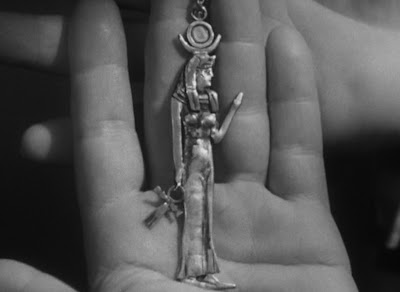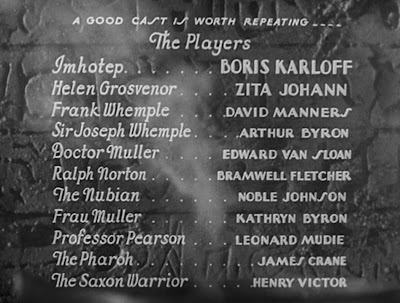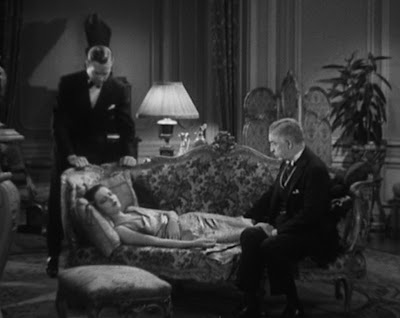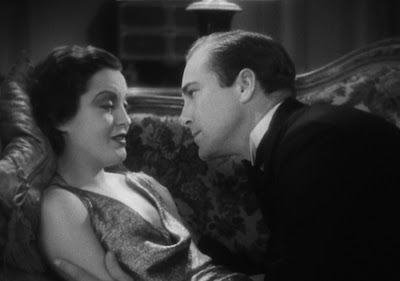Anyway, Dr. Muller is certain that Frank is next on Imhotep's hit list, so he urges him to protect himself with an amulet of Isis.

Okay, well, strictly speaking, that looks a lot more like Hathor. But the two goddesses were closely linked, and Isis was sometimes depicted with Hathor-like iconography, so that's really not a huge problem.
But Frank is not particularly interested in any of this. He's a lot more concerned about whether Helen likes him or just likes him. Sigh.
Helen, meanwhile, is under Imhotep's spell again. I just want to mention here that the portrayal of ancient Egyptian magic in this movie is not that far off the mark. The idea of magic (heqa) is found in all periods of ancient Egyptian history, and performative speech (i.e. the recitation of spells, with the idea that the act of stating that the desired result has happened/will happen will magically cause that thing to happen) was a common form of magical practice. The story of Setna and the mummies, which is the major inspiration for The Mummy, contains several of the elements present here: in particular, the reanimation of corpses and the use of controlling "love spells".
Anyway, Helen, under the influence of Imhotep's magic, goes out and finds her way to Imhotep's bachelor pad.
 That's a statue of Bastet back there. There's also an unfriendly white cat on the premises. Apparently Imhotep is exercising his death magic with the assistance of "Bast, the goddess of evil sendings." I think they're confusing poor Bastet with her more ferocious aspect, the lioness Sekhmet. Sekhmet is the kind of goddess you want to sic on your enemies. Bastet is more of a motherly, protective sort.
That's a statue of Bastet back there. There's also an unfriendly white cat on the premises. Apparently Imhotep is exercising his death magic with the assistance of "Bast, the goddess of evil sendings." I think they're confusing poor Bastet with her more ferocious aspect, the lioness Sekhmet. Sekhmet is the kind of goddess you want to sic on your enemies. Bastet is more of a motherly, protective sort.With the help of his magic jacuzzi, Imhotep shows Helen a lengthy flashback to the events that led up to his mummification. This is one of the most fun sequences in the movie, and the urge to take a million screencaps was overwhelming. I'm going to have to restrain myself here. The whole thing is filmed in the style of a classic silent film, only with sparse voice-over narration instead of title cards. There are some lovely funerary procession scenes that were clearly well researched. There is also some hilarious period costume:
 Hahaha! Actually, that's not too bad, although it strikes me as more Ramesside than 18th Dynasty. And I don't know what's going on with the cape or his hair (?) sticking out from under the crown. I think that's the double crown, although it's hard to tell in this picture. What's that stuff all around the crown? Is that supposed to be a band of uraei? Also, those scenes and fake glyphs on the wall behind him are pretty goofy.
Hahaha! Actually, that's not too bad, although it strikes me as more Ramesside than 18th Dynasty. And I don't know what's going on with the cape or his hair (?) sticking out from under the crown. I think that's the double crown, although it's hard to tell in this picture. What's that stuff all around the crown? Is that supposed to be a band of uraei? Also, those scenes and fake glyphs on the wall behind him are pretty goofy.You're probably familiar with the basic premise here: Imhotep (apparently a priest of Ptah, from the look of his garb) was in love with Ankhesenamun. Ankhesenamun was a daughter of the king and also a priestess of Isis (one of those "vestal virgins" that was mentioned back at the beginning of the movie). Imhotep stole the Scroll of Thoth and tried to resurrect Ankhesenamun with it when she died, presumably from some sort of illness. He was caught and sentenced to "the nameless death" (i.e., being buried alive), and the scroll was buried with him to prevent further misuse.
By the way, I don't know of any examples of live mummification as a form of execution in ancient Egypt. They had plenty of gruesome ways of killing people, but that wasn't one of them as far as I know. Unfortunately, these mummy movies have created a modern misconception of mummification as a form of punishment, which it wasn't.
Helen eventually goes home, dazed, disturbed and frightened, and finds Frank waiting for her.
 Helen: "Oh god, I'm terrified and I'm losing my grip on reality! Help me!"
Helen: "Oh god, I'm terrified and I'm losing my grip on reality! Help me!"Frank: *silent fist pump*
Dr. Muller has figured out what's going on by now and decides it's best to let things run their course. Next time Imhotep calls, Helen must go to him. Naturally, Frank ignores everything that Dr. Muller has told him and tries to protect Helen by taking off the Isis amulet and hanging it on her door. I'm sure you can guess how well that works out.
 Oh, Frank.
Oh, Frank.So Helen goes back to the museum, where Imhotep has broken in and killed the guards. He's set up an impromptu embalming workshop and sacrificial altar in the Ankhesenamun exhibit.
 He destroys Ankhesenamun's mummy (guess she won't be needing that old thing anymore) and tells her that he's going to, uh . . . kill her, so that she can live forever. Well, okay. I guess. Understandably, Helen/Ankhesenamun freaks out at this point. Imhotep manages to temporarily subdue her, but she eventually gets off the altar and begins praying to Isis for assistance.
He destroys Ankhesenamun's mummy (guess she won't be needing that old thing anymore) and tells her that he's going to, uh . . . kill her, so that she can live forever. Well, okay. I guess. Understandably, Helen/Ankhesenamun freaks out at this point. Imhotep manages to temporarily subdue her, but she eventually gets off the altar and begins praying to Isis for assistance.Meanwhile, Frank has revived, and he and Dr. Muller rush to the museum, where they see all the mummy smoke billowing out of the chimney. Ew. PS, why is there a fireplace in the middle of the gallery?
Anyway, our two heroes arrive just in the nick of time . . .

 . . . to stand there helplessly while Ankhesenamun invokes the protective magic of Isis. Luckily for (almost) everyone involved, Imhotep moves really, really slowly. Isis zaps Imhotep and he crumbles into a pile of dust and bones, and Frank rushes to Helen's side.
. . . to stand there helplessly while Ankhesenamun invokes the protective magic of Isis. Luckily for (almost) everyone involved, Imhotep moves really, really slowly. Isis zaps Imhotep and he crumbles into a pile of dust and bones, and Frank rushes to Helen's side. "Thank God I saved you!"
"Thank God I saved you!"The End! Let's see if they repeat the credits. Yep, here we go:
 Ah, that was a good cast, and actually a darn good movie. I only had a few major compla--
Ah, that was a good cast, and actually a darn good movie. I only had a few major compla--Hey, wait a minute. Go back. "The Saxon Warrior"? What Saxon warrior? Do they mean this kind of Saxon? I don't remember any Saxons in this movie. Why would there be any Saxons in this movie? Is this from some scene that got cut out? If so, what the hell would the context have been?
Huh.































